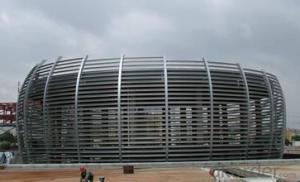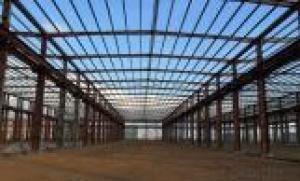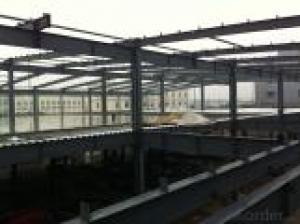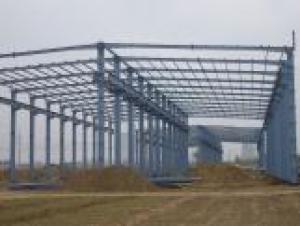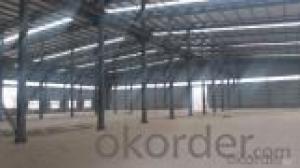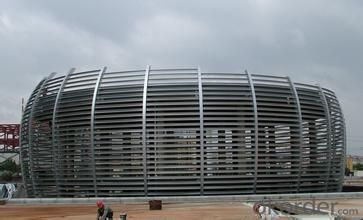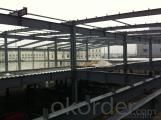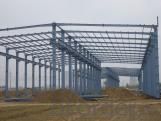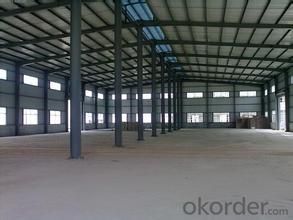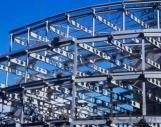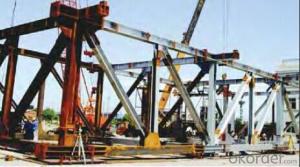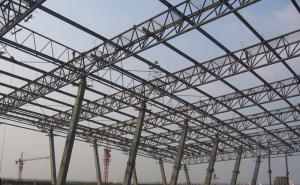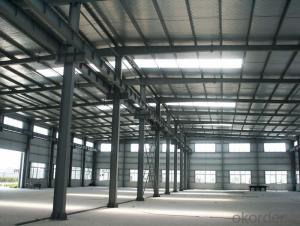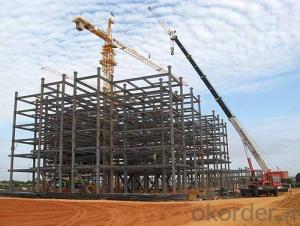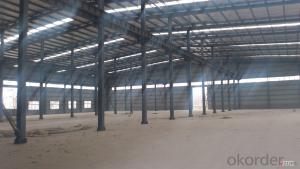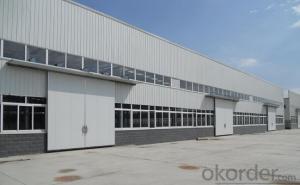Steel Structure Workshop And Steel Structure Warehouse With High Quality
- Loading Port:
- China Main Port
- Payment Terms:
- TT or LC
- Min Order Qty:
- -
- Supply Capability:
- -
OKorder Service Pledge
OKorder Financial Service
You Might Also Like
OKorder is offering Steel Structure Workshop and Steel Structure Warehouse with high qualityat great prices with worldwide shipping. Our supplier is a world-class manufacturer of steel, with our products utilized the world over. OKorder annually supplies products to European, North American and Asian markets. We provide quotations within 24 hours of receiving an inquiry and guarantee competitive prices.
Product Applications:
Steel Structure Workshop and Steel Structure Warehouse with high quality are ideal for structural applications and are widely used in the construction of buildings and bridges, and the manufacturing, petrochemical, and transportation industries.
Product Advantages:
Steel Structure Steel Structure Workshop and Steel Structure Warehouse with high qualityare durable, strong, and resist corrosion.
Main Product Features:
· Premium quality
· Prompt delivery & seaworthy packing (30 days after receiving deposit)
· Corrosion resistance
· Professional Service
· Competitive pricing
Product Specifications:
Project: Jinan west railway station
Position: The Beijing-Shanghai high speed railway (Jinan)
Steel dosage: 5000MTs
Structure type: Box, tube, bending and twisting, transverse connection
1. GB standard material
2. High Structural safety and reliability
3. The production can reach GB/JIS/ISO/ASME standard
Packaging & Delivery of steel structure
1. According to the project design and the component size, usually the main component parts are nude packing and shipped by bulk vessel. And the small parts are packed in box or suitable packages and shipped by containers.
2. This will be communicated and negotiated with buyer according to the design.
Engineering Design Software of steel structure
Tekla Structure \ AUTO CAD \ PKPM software etc
⊙Complex spatial structure project detailed design
⊙Construct 3D-model and structure analysis. ensure the accuracy of the workshop drawings
⊙Steel structure detail ,project management, automatic Shop Drawing, BOM table automatic generation system.
⊙Control the whole structure design process, we can obtain higher efficiency and better results
Technical support of steel structure
Worker | Rate of frontline workers with certificate on duty reaches 100% |
Welder | 186 welders got AWS & ASME qualification 124 welders got JIS qualification 56 welders got DNV &BV qualification |
Technical inspector | 40 inspectors with UT 2 certificate 10 inspectors with RT 2 certificate 12 inspectors with MT 2 certificate 3 inspectors with UT3 certificate |
Engineer | 21 engineers with senior title 49 engineers with medium title 70 engineers with primary title. 61 First-Class Construction Engineers 182 Second-Class Construction Engineers |
International certification | 10 engineers with International Welding engineer, 8 engineers with CWI. |
Production Flow of steel structure/steel frame
Material preparation—cutting—fitting up—welding—component correction—rust removal—paint coating—packing—to storage and transportation (each process has the relevant inspection)
FAQ:
Q1: Why buy Materials & Equipment from OKorder.com?
A1: All products offered byOKorder.com are carefully selected from China's most reliable manufacturing enterprises. Through its ISO certifications, OKorder.com adheres to the highest standards and a commitment to supply chain safety and customer satisfaction.
Q2: How do we guarantee the quality of our products?
A2: We have established an advanced quality management system which conducts strict quality tests at every step, from raw materials to the final product. At the same time, we provide extensive follow-up service assurances as required.
Q3: Can stainless steel rust?
A3: Stainless does not "rust" as you think of regular steel rusting with a red oxide on the surface that flakes off. If you see red rust it is probably due to some iron particles that have contaminated the surface of the stainless steel and it is these iron particles that are rusting. Look at the source of the rusting and see if you can remove it from the surface.
Images:
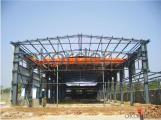
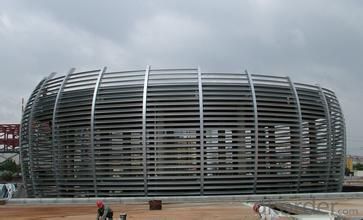
- Q: How are steel structures used in security and surveillance systems?
- Steel structures are widely used in security and surveillance systems due to their strength, durability, and versatility. These structures provide a secure and stable foundation for various components of security and surveillance systems. One common application of steel structures in security and surveillance systems is the installation of CCTV cameras. Steel poles or towers are used to mount these cameras at elevated positions, allowing for a better view of the surroundings. The strength of steel ensures that the cameras remain stable and can withstand harsh weather conditions, preventing any potential damage or tampering. In addition to camera installations, steel structures are also utilized for the construction of control rooms and monitoring stations. These structures provide a safe and secure environment for security personnel to monitor surveillance footage and control various security systems. Steel's durability ensures that these structures can withstand external threats and safeguard the valuable equipment and personnel inside. Moreover, steel structures are used to create barriers and fences in high-security areas. These structures act as a physical deterrent, preventing unauthorized access and intrusions. Steel fences are difficult to breach, and their strong and rigid nature makes them resistant to cutting or tampering, enhancing the overall security of the premises. Furthermore, steel structures are often employed for the construction of access control systems, such as gates and turnstiles. These structures provide a sturdy framework for the integration of electronic security measures, such as biometric scanners or card readers, ensuring only authorized individuals can gain entry. Steel's strength makes it difficult to break through, adding an extra layer of security to these access control systems. Overall, steel structures play a crucial role in the security and surveillance industry. Their strength, durability, and versatility make them ideal for supporting various components of these systems, including camera installations, control rooms, fences, and access control systems. By utilizing steel structures, security and surveillance systems can achieve a higher level of protection and ensure the safety of people and assets.
- Q: What is the purpose of steel beams in structures?
- Steel beams serve the purpose of providing structural support and stability in various structures. With their strength and durability, they are capable of withstanding heavy loads and resisting bending or buckling when subjected to pressure. They find common usage in the construction of buildings, bridges, and other large structures to evenly distribute weight and prevent collapse. Moreover, steel beams enable the creation of open and flexible floor plans as they can span long distances without the necessity of additional support columns. Furthermore, steel beams possess fire resistance, rendering them suitable for structures that require enhanced safety measures. Ultimately, the aim of steel beams is to guarantee the integrity and longevity of a structure by establishing a solid and dependable framework.
- Q: How are steel structures affected by corrosion and rust?
- The structural integrity of steel is significantly impacted by corrosion and rust. When steel is exposed to oxygen and moisture over time, corrosion occurs as a natural process. This results in the formation of rust, which weakens the steel's structural integrity. Rust develops when iron in the steel reacts with oxygen in the presence of moisture. The process of rusting causes the steel to deteriorate, leading to a decrease in strength and stability. Rust forms on the steel's surface and expands, creating cracks and fissures that further compromise the structural integrity. Corrosion and rust can have serious consequences for steel structures. The strength and load-bearing capacity of the steel can be greatly reduced, making the structure more prone to collapse or failure. This poses a significant safety risk, especially in critical infrastructures like bridges, buildings, and industrial facilities. To prevent or minimize the effects of corrosion and rust, various protective measures can be implemented. One common approach is the application of protective coatings, such as paint or specialized anti-corrosion coatings. These coatings act as a barrier, preventing moisture and oxygen from reaching the steel surface. Regular inspections and maintenance are also essential to detect and address any signs of corrosion or rust at an early stage. In conclusion, corrosion and rust are major concerns for steel structures as they can compromise their structural integrity. Implementing proper preventive measures and conducting regular maintenance are crucial to ensure the long-term durability and safety of steel structures.
- Q: How are steel structures designed to accommodate for differential settlement?
- Steel structures are designed to accommodate for differential settlement by using flexible connections and adjustable supports. These design features allow the steel components to move independently and adjust their positions, reducing the impact of differential settlement on the overall structure. Additionally, engineers may also incorporate additional measures such as flexible joints or expansion joints to further mitigate the effects of differential settlement on steel structures.
- Q: How do steel structures comply with building codes and regulations?
- Steel structures comply with building codes and regulations by following the specific guidelines and standards set by local, state, and national authorities. These codes dictate the design, construction, and safety requirements for steel structures, ensuring they meet structural integrity, fire safety, occupancy, and accessibility standards. Steel structures undergo rigorous testing, quality control measures, and inspections to ensure compliance with these codes, ultimately ensuring the safety and durability of the building.
- Q: How are steel structures designed to accommodate architectural finishes?
- Steel structures are designed to accommodate architectural finishes by considering the weight and support requirements of the finishes during the design phase. The structural engineers work closely with the architects to ensure that the steel framework can adequately support the weight and load of the chosen finishes, such as cladding or facade systems. The design also takes into account the necessary fixings and connections to securely attach the finishes to the steel structure. Overall, steel structures are meticulously planned to provide a stable and reliable framework for architectural finishes to be seamlessly integrated.
- Q: What are the factors to consider when designing steel structures for mixed-use developments?
- When it comes to designing steel structures for mixed-use developments, there are numerous factors that demand meticulous attention. These factors encompass: 1. Structural Integrity: The steel structure must possess the capability to withstand the combined loads exerted by the various components within the mixed-use development, such as residential, commercial, and recreational spaces. It is imperative to guarantee that the structure can endure the maximum loads applied to it, including dead loads (the weight of the structure itself) and live loads (occupancy and usage). 2. Flexibility and Adaptability: Mixed-use developments frequently necessitate designs that can easily accommodate changes in use or future renovations. Steel structures are renowned for their adaptability, as they can be effortlessly modified or expanded without compromising the overall integrity of the building. The design should allow for effortless reconfiguration of spaces to meet the evolving needs of the development. 3. Fire Resistance: Fire safety is an essential consideration in any building design, particularly in mixed-use developments where different occupancies coexist. Steel structures should be designed to meet fire resistance requirements, including the implementation of proper fireproofing measures and compartmentalization strategies. The choice of fire-resistant materials and the inclusion of fire protection systems should also be taken into account. 4. Acoustic and Thermal Comfort: Mixed-use developments often encompass adjacent spaces with distinct requirements for acoustic and thermal comfort. The design should incorporate appropriate insulation and soundproofing measures to minimize noise transfer between residential, commercial, and recreational spaces. It is also crucial to carefully consider thermal insulation to maintain comfortable indoor temperatures and promote energy efficiency. 5. Aesthetic Integration: Mixed-use developments necessitate a cohesive architectural design that seamlessly integrates the different functionalities and uses of the building. Steel structures offer a wide array of design possibilities, ranging from exposed steel frames to sleek and modern finishes. The design should take into consideration the visual harmony and overall aesthetic appeal of the building to create a unified and visually pleasing environment. 6. Sustainability: Environmental sustainability is an increasingly pressing concern in construction projects. Steel structures inherently possess sustainable qualities, such as high recyclability and reduced waste during construction. The design should incorporate sustainable practices, such as the efficient utilization of materials, energy-efficient systems, and the incorporation of green spaces or renewable energy sources. 7. Cost-effectiveness: Finally, the cost-effectiveness of the steel structure design is a crucial factor to consider. Steel structures offer advantages such as shorter construction time, reduced maintenance requirements, and long-term durability. However, the design should strike a balance between these advantages and the project's budget and overall cost considerations. To conclude, the design of steel structures for mixed-use developments necessitates careful consideration of various factors, including structural integrity, flexibility, fire resistance, acoustic and thermal comfort, aesthetic integration, sustainability, and cost-effectiveness. By addressing these factors, a well-designed steel structure can provide a safe, functional, and visually appealing environment for mixed-use developments.
- Q: How are steel commercial buildings constructed?
- Steel commercial buildings are constructed using a combination of pre-engineered steel components and on-site assembly. The process involves the fabrication and delivery of steel frames, beams, columns, and panels which are then assembled by skilled workers at the construction site. The steel components are bolted or welded together to form the building's structural system, providing strength, durability, and flexibility. This method allows for faster construction times, cost-effectiveness, and the ability to customize the design to meet specific requirements.
- Q: How do steel structures withstand environmental forces such as wind and earthquakes?
- Steel structures are able to withstand environmental forces such as wind and earthquakes due to their inherent properties and design considerations. Firstly, steel is a very strong and durable material, which gives it the ability to resist the forces exerted by wind and earthquakes. It has a high tensile strength, meaning it can withstand tension forces without breaking or deforming. This is crucial in wind resistance as it allows steel structures to resist the lateral forces generated by strong winds. Additionally, steel structures can be designed to distribute these forces evenly throughout the structure, minimizing localized stress concentrations. In terms of earthquakes, steel structures have several features that make them resilient. One important factor is their ability to flex and bend under seismic forces. Steel is a highly ductile material, meaning it can undergo significant deformation without fracturing. This flexibility allows the structure to absorb and dissipate the energy generated by an earthquake, reducing the impact on the overall structure. Furthermore, steel structures can be designed to incorporate specific seismic-resistant features, such as base isolators and damping systems. Base isolators are devices placed between the foundation and structure that help absorb and dissipate seismic energy. Damping systems, on the other hand, use materials or mechanisms to absorb and dissipate the energy generated by oscillations during an earthquake. Lastly, the construction techniques used in steel structures, such as bolted connections, add to their ability to withstand environmental forces. Bolted connections provide a high level of rigidity and strength, ensuring that the structure remains intact even under extreme conditions. Overall, steel structures have the ability to withstand environmental forces such as wind and earthquakes due to their strength, flexibility, and specific design considerations. These properties make steel an ideal material for constructing buildings and infrastructure in areas prone to such natural hazards.
- Q: How are steel structures used in the construction of government buildings?
- Steel structures are commonly used in the construction of government buildings due to their durability, strength, and versatility. They provide the necessary support and stability required for large-scale structures, ensuring the safety of occupants. Steel also allows for flexible design options, enabling architects to create unique and aesthetically pleasing government buildings. Additionally, steel structures are fire-resistant, which is crucial for ensuring the protection of important government documents and personnel. Overall, steel plays a vital role in constructing government buildings that are secure, functional, and visually appealing.
Send your message to us
Steel Structure Workshop And Steel Structure Warehouse With High Quality
- Loading Port:
- China Main Port
- Payment Terms:
- TT or LC
- Min Order Qty:
- -
- Supply Capability:
- -
OKorder Service Pledge
OKorder Financial Service
Similar products
Hot products
Hot Searches
Related keywords
